Varicosis is a disease of the legs that not only spoils the aesthetic appearance of a person, but can also lead to a number of serious complications.The main causes, symptoms and methods for the treatment of varicose veins on the legs are later described in detail.
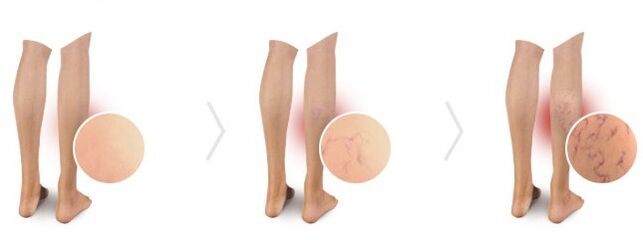
Medical certificate - varicose veins
Varicose veins - a chronic disease of the peripheral veins of the lower extremities with a progressive course.It is characterized by a pathological expansion of the veins, which manifests itself by a violation of the reverse blood flow due to the weakness of the flaps and the wall of the vessels.As a result, there is a stagnation of venous blood and an increase in pressure in veins, the walls of which lose elasticity over time and to stretch and deform.After the international classification of diseases, ICD 10 varicose veins of the lower extremities have code 183.
The causes of the disease
The etiology of varicose veins is not well examined.Doctors look at the disease polyetiologically, but differentiate several development theories:
- Mechanical theory. Excessive stress on the lower limbs: with standing work (surgeons, dentists, teachers, hairdressers), athletes, pregnant women.
- Neuroendocrine theory. Due to the hormonal shift (pregnancy, menopause, sexual maturation), the tone of the walls of blood vessels is reduced.
- Genetic predisposition.Congenital functional underdevelopment of flaps in the veins.
Risk factors for the development of varicose veins:
- female gender;
- Inheritance;
- Obesity;
- Load loads;
- A sitting lifestyle.
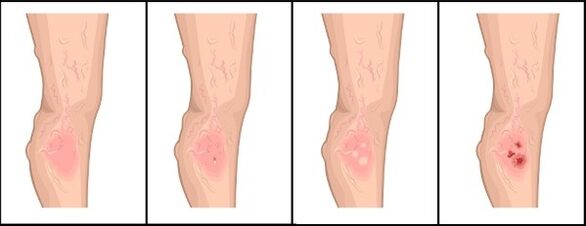
Symptoms of the disease
The manifestations of the disease are:
- The appearance of a vascular network in the form of stars on the skin is the telangioectasia.
- Skin changes: drought, pigmentation.In the later stages - dermatitis, eczema, trophic ulcers.
- A characteristic that curves through the skin excusable veins on the lower extremities.
- The appearance of pain and symptoms in the legs, especially after physical exertion.The pain can have a different character (pulsating, burning, painful), the time of occurrence (pain when walking, at the end of the day, at night).
- The development of edema and seizures of the calf muscles.First a swelling is observed in the foot area of the foot and then applies to the lower leg.
Development stages of varicose veins
The disease develops stages and slowly.It can take several years when its first symptoms occur.
- Level 0. It is characterized by non -specific features such as severity and symptoms in the legs that can be symptoms and other diseases (osteochondrosis, flat feet).At this stage, the disease is difficult to diagnose due to the lack of the main attribute.
- Level 1. Changes on the skin - vascular stars are attached to the above -mentioned symptoms.
- Level 2. The enlarged swollen and winding veins, nodules are characteristic.
- Level 3. The appearance of edema is particularly pronounced at the end of the day.
- Stage 4. It manifests itself through irreversible changes in the blood vessels and trophic lesions of the legs due to an impaired bloodstream and an inadequate diet of tissues.Strong skin pigmentation (dark brown color) is characteristic.
- Level 5. Healing Trophic Ulkus.
- Stage 6. Trophic ulcer is not heated.
Possible complications

The disease itself is not dangerous for life, but its complications are dangerous due to early or improper treatment:
- Acute thrombophlebitis of surface veins - inflammation of the walls of blood vessels, the formation of blood clots from blood clots that carried out a bloodstream in the tissues;
- Lung artery Thromboembolism - blockade of the lumen of the lung artery with a thrombus that broke off from the wall of the vessel often has death;
- Phlebet trombosis;
- Trophic ulcer - occurs due to poor tissue nutrition with blood with advanced forms of varicose veins;
- Bleeding from nodes.
When to see a doctor
Varicose veins are diagnosed and treated by a phlebologist (cardiovascular surgery).In order not to miss the insertion of the disease, you must contact a specialist in the first signs:
- The appearance of vascular stars on the legs;
- A feeling of symptoms in the legs, pain;
- Swelling and fast tiredness;
- Night cramps;
- significantly expanded veins.
Varicose veins on the legs, the treatment of which was promptly and effective, threatens the occurrence of complications less.
Diagnostic measures
So far, the main diagnosis method is ultrasound.Such measures are carried out when diagnosing varicose veins:
- Ultrasonic topping. A method that combines the use of ultrasound and Doppler diagnostics and enables them to evaluate the type of blood movement by the vessels, the presence of a reverse blood shot, the blood clot, the condition of the vessels on average, the operation of the venous flotation (the presence of flotation) and the subsequent of the peripheral and deep Veins.There are different types: colored topics, duplex and triplex double.
- Duplex scan (sonography) is a kind of ultrasound dopperography in which 2 methods are used: in-fashion and color dopperography.Allows you to determine the presence of blood clots, their size, the type of place, the possibility of separation.The method is not invasive, can determine a diagnosis with great accuracy and determine further treatment tactics.
- Phlebanometry - a method for determining blood pressure on the walls of the veins.
- Phleboscintigraphy - the introduction of a radiopharmacy in Vienna and observation using a special device.The method is used for the combined pathology of the veins and the lymphatic system.
- Phlebography is a radiological method that implies the introduction of an X -Ray contract intravenously.In an X -Ray picture, the doctor evaluates the status of the veins.Suitable for the diagnosis of deep veins when the ultrasonic double -topography has been wrapped.
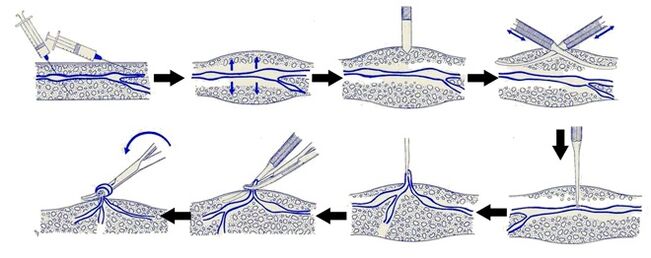
The last two methods are invasive, have a number of contraindications (allergies to a contrast medium) and are rarely used today for diagnostic purposes.
Treatment methods
Varicose veins on the legs, the treatment of which is carried out with two main methods in the complex (conservative and surgical), has a favorable forecast.Conservative methods:
- Drug treatment;
- the use of traditional medicine;
- Physiotherapy;
- Compression therapy includes the use of special underwear.
- Sclerotherapy.
Surgical methods:
- Varadi operation - removal of affected veins (phlebectomy);
- Laser coagulation of veins.
External treatment with creams, ointments and gels
The external use of creams, ointments and gels acts as a tool in the early stages of the disease.Preparations help reduce swelling, reduce pain, increase the tone of the venous walls.
Laser treatment
Lazamaria treatment (laser coagulation or ablation) is a minimally invasive method used in pronounced forms of the disease.Use lasers with different wavelengths.The laser light is inserted into the lumen of the veins and glues its walls.Such a vein will come off in the future.The procedure takes place under the control of the ultrasound and does not leave after the strong bruises. Advantages of laser treatment: lack of recovery phase, painlessness and safety of the procedure, a minimum of postoperative complications, scars and pigmentation.
Sclerotherapy
Sclerotherapy - is the introduction of a special medicine (sclerosants) to the affected vein, which it is from the inside and disappears over time.There are different types of this methodology: echosclerotherapy, microclerotherapy.The procedure takes 20 minutes, Sclerotherapy meetings from 3 to 5. This treatment method is widespread in many countries around the world and delivers a long result and in the first phases - for life.In the case of advanced and heavy forms, however, sclerotherapy does not provide a hundred percent guarantee.
Hydrotherapy
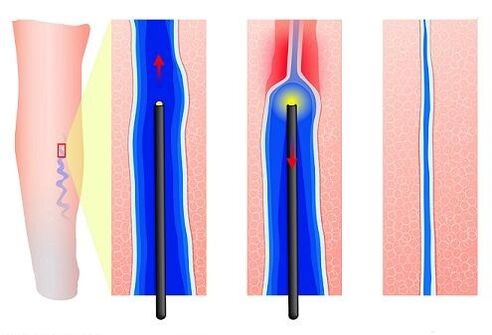
The treatment of hydrotherapy (water therapy) in the form of different types of bathrooms (with herbs, salt) and shower (circular, massage, contrast) helps to reduce the lumen of blood vessels, to alleviate the fatigue and swelling of the legs.
The use of stockings and tights from varicose veins
The use of compression laundry (attracting) helps in the early stages of varicose veins by eliminating blood tag nation in peripheral veins and redistribution by expanded vessels into healthy people. The use of such knitted lines is possible for preventive purposes and during rehabilitation.
Surgical therapy
The surgical removal of the affected veins - phlebectomy is a radical, complex but most effective method (almost 100% healing).However, phlebectomy has a number of contraindications: diseases of the heart cycle system, liver, kidneys, pregnancy.After operation, you have to wear a delayed compression laundry for a month or apply an elastic bandage on your leg.
Physiotherapy
The treatment of varicose veins using physiotherapeutic methods is effective in the early stages of the disease and in complex therapy.Widespread: laser therapy, darsonvalization, magnetic laser therapy, pneumocompression, UHF, Balneo and Mudrapie.Physiotherapy helps to strengthen the walls of blood vessels improves the operation of valves, microcirculation and lymphocid in the limbs.A visible result is achieved through regular course treatment in combination with other therapy methods.
Folk remedy
Treatment with folk remedies of varicose veins on the legs is widespread in patients.However, it should be taken into account that all methods of non -traditional medicine are ineffective in severe forms of the disease.Popular remedies for the treatment of varicose veins:
- Tinctures of medical herbs: calanchoe, nettle, horse chestnuts, ginseng root, nutmeg;
- Lotions and compresses made of sound, honey;
- Soda baths, sea salt;
- Ointments (Vishnevsky);
- Hirudotherapy (treatment with medical leeches).
Use of apple cider vinegar with apple cider vinegar

The use of apple cider vinegar to treat varicose veins is recommended by many specialists.It is advisable to cook the product yourself and not to buy in the shop.To prepare vinegar, you have to grind sweet apples and then pour them 3 cm above warm water.Let the product infuse for 2 weeks and sometimes stir with a wooden spoon.Slide and add several spoons in a glass of water to grate.Vinegar can be rubbed into the skin of painful legs, compresses, winding and making baths.The tool strengthens the venous wall, improves blood circulation in them, reduces swelling.
Use lotions and sound compresses
Blue tone in the form of lotions and compresses is often used for preventive purposes and with early manifestations of varicose veins. Place the powder diluted with warm water with a thick layer on your feet, wrap it in with clammy film and wrap it in with a warm scarf.Keep the application for 40 minutes.Or apply to a gauze affected by a gauze for 30 minutes, which is greased with clay with chopped garlic.Such therapy with regular use (2-3 weeks) effectively relieves symptoms in legs, swelling and tiredness.
With a tincture of acacia flowers
A tincture of the white acacia colors is used to treat varicose veins.To prepare it, you have to fill the raw materials in a 3-liter glass and cover 0.5 liters of vodka and medical alcohol on 1/3 with a lid.Pass a mixture in a dark place for two weeks.Lubricate painful legs with the finished tincture 5-7 times a day.The tincture will help relieve the symptoms of varicose veins.
With ginseng tincture
Ginseng root is a natural tonic to strengthen venous vessels.The finished tincture can be bought in a pharmacy or prepared independently by pouring 0.5 liters of vodka 150 g of crushed ginseng.Pass the liquid in a dark place for 2 weeks.Tincture to take 1-2 tablespoons of 4 times a day with an empty stomach.
Nettle
The healing properties of nettles have long been known.The plant improves blood circulation, prevents blood tag nation and strengthens the walls of blood vessels.In order to prepare the therapeutic decoction of nettle, the crushed fresh or dry leaves pour a liter of boiling water.Pass for a few hours and strain.Drink a third of a third of a glass for a month three times a day.
Use potatoes
Effective the use of potatoes for varicose veins in the form of compresses, lotions.For compression, mix the freshly launched tuber with a spoonful honey and apply to wound areas, fix a film and a bandage at the top. Keep a compress of 5 hours and wash it off with warm water.The course of treatment is 3 weeks. The compress helps to remove swelling, pain, a vascular network on the legs.
Prevention of varicose veins
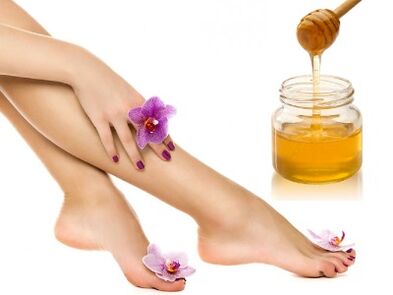
In order to prevent the development of varicose veins, it is worth observing the following measures, especially those who are at risk:
- Keep weight normal;
- Avoid standing longer;
- If you walk more, practice legs;
- Limit the wearing of shoes with a high bargain;
- Limit the use of alcohol and cigarettes;
- participate in sports (swimming, cycling, aerobics);
- Water processes (against shower, relaxing baths for the legs);
- Wear compression underwear;
- Stick to the right nutrition.
Varicose veins on the legs - treatment and diagnosis - important components of fast recovery.So far there are a number of medication and means of non -traditional medicine that promise to get rid of varicose veins.
If the varicose veins on the legs are not ignored and the treatment begin with the treatment in good time, there is a high percentage of the low prognosis.Conservative therapy is shown in the initial phase: medication, creams, compression knitting clothing, physiotherapy, traditional drug recipes.In pronounced forms - laser ablation, the removal of advanced veins.



















